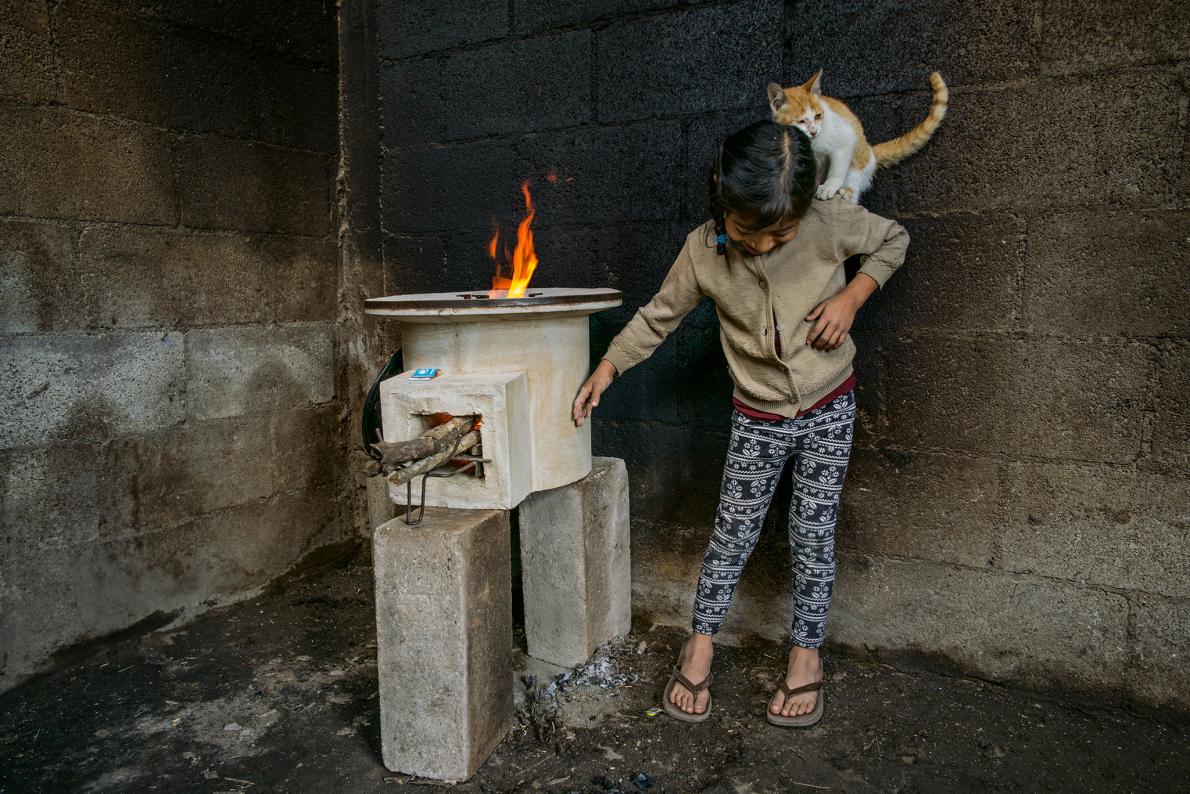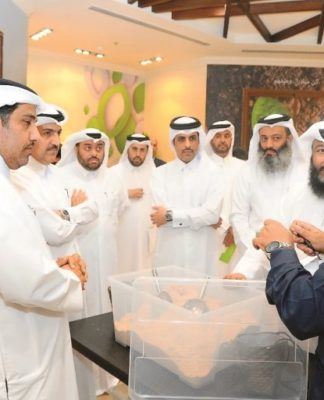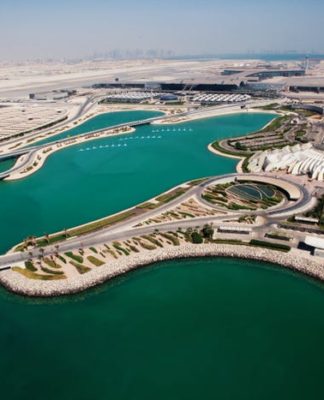“The best thing about being a girl is, now I don’t have to pretend to be a boy.” – Avery Jackson, Kansas City, Missouri.
This photo was originally published in, “In Their Words: How Children Are Affected by Gender Issues,” in January 2017.
PHOTOGRAPH BY ROBIN HAMMOND, NATIONAL GEOGRAPHIC
A tourist on a boat in Laguna San Ignacio reaches into the water in the hope of petting one of many gray whales that frequent the bay to mate and care for their young. Once feared by fishermen, the unusually friendly animals are now a crucial part of the economy.
This photo was originally published in “Baja California’s Recipe for Saving Fishing Communities,” in September 2017.
PHOTOGRAPH BY THOMAS P. PESCHAK, NATIONAL GEOGRAPHIC
As darkness falls on Guassa, geladas break into a run down a slope toward their sleeping cliffs. They will spend the night perched on narrow rocky ledges, trying to stay safe from leopards, hyenas, and feral dogs.
This photo was originally published in “Where the World’s Only Grass-Eating Monkeys Thrive,” in April 2017.
PHOTOGRAPH BY JEFFREY KERBY AND TREVOR BECK FROST, NATIONAL GEOGRAPHIC
Colin Murdoch, who manages the deer population at Reraig Forest, near Loch Carron, feeds stags to spur antler growth. In addition to offering stalking, the property hosts wilderness tours.
This photo was originally published in, “What Will Become of Scotland’s Moors?,” in May 2017.
PHOTOGRAPH BY JIM RICHARDSON, NATIONAL GEOGRAPHIC
On a farm in Kentucky, Emma Langley, 13, Camille McCay, 10, and “Emerald” Shean, 10, play on a break from a daylong mother-daughter retreat to help girls understand and appreciate their bodies as they change with the onset of puberty.
This photo was originally published in, “A Challenge for Girls Today: Moving Beyond ‘How Do I Look?’,” in January 2017.
PHOTOGRAPH BY KITRA CAHANA, NATIONAL GEOGRAPHIC
Wearing a curtain and a cardboard crown, Kristina Khudi becomes the “tundra princess” in the Nenets camp near the Kara Sea. The eight-year-old says her happiest time is summer, when a helicopter sent by Gazprom and the regional government brings her and other kids home from school to their migrating families.
This photo was originally published in, “They Migrate 800 Miles a Year. Now It’s Getting Tougher.,” in October 2017.
PHOTOGRAPH BY EVGENIA ARBUGAEVA, NATIONAL GEOGRAPHIC
The Zetas hold on the state of Coahuila has been weakened, and nightlife has returned to Allende. Hundreds of people gathered last fall for the cabalgata, a festive cowboy parade that goes on for two to three days, stops at several ranches across the area, and ends with an evening rodeo.
This photo was originally published in “How the U.S. Triggered a Massacre in Mexico,” in July 2017.
PHOTOGRAPH BY KIRSTEN LUCE, NATIONAL GEOGRAPHIC
Fireflies dart in the forest at Santa Clara Sanctuary.
This photo was originally published in “How Fireflies Are Keeping This Tiny Mexican Town Alive,” in August 2017.
PHOTOGRAPH BY KIRSTEN LUCE, NATIONAL GEOGRAPHIC
In Seoul, e-stadiums and gaming parlors charge about a dollar an hour, and some venues are open around the clock. Soon after South Korea made super-high-speed Internet cheap and widely available, it became clear that some people were ruining their lives through obsessive game playing. The government now pays for treatment.
This photo was originally published in “How Science Is Unlocking the Secrets of Addiction,” in September 2017.
PHOTOGRAPH BY MAX AGUILERA-HELLWEG, NATIONAL GEOGRAPHIC
Hamid, 16, cooks in an abandoned space in Sid. UNICEF’s Michel Saint-Lot says he hopes children like Hamid will apply for asylum in Serbia rather than risk continuing their dangerous journeys.
This photo was originally published in “Thousands of Refugee Children Are Stranded on Europe’s Doorstep,” in October 2017.
PHOTOGRAPH BY MUHAMMED MUHEISEN, NATIONAL GEOGRAPHIC
In 2011, the Zetas cartel, seeking revenge against members believed to be informants, rampaged through Allende and neighboring towns, killing dozens, and possibly hundreds. For this stricken community, the Day of the Dead holiday, when Mexicans honor their ancestors, has taken on extra poignancy.
This photo was originally published in “How the U.S. Triggered a Massacre in Mexico,” in July 2017.
PHOTOGRAPH BY KIRSTEN LUCE, NATIONAL GEOGRAPHIC
Angelito Luciano, 41, was a local volunteer community official who assisted police with anti-drug operations. He was killed in what appears to be a drug-related execution, according to police reports.
This photo was originally published in, “In Philippine Drug War, Death Rituals Substitute for Justice,” in February 2017.
PHOTOGRAPH BY ADAM DEAN, NATIONAL GEOGRAPHIC
In northern India the neem tree is known as the curer of all ailments and a manifestation of the Hindu goddess Shitala, a mother figure. To neighborhood residents who worship the tree at the Nanghan Bir Baba Temple, in Varanasi, it is that and more. The tree is dressed in cloth and wears a face mask of the goddess to strengthen the connection between her and worshippers.
This photo was originally published in “What We Can Learn from Trees,” in March 2017.
PHOTOGRAPH BY DIANE COOK AND LEN JENSHEL, NATIONAL GEOGRAPHIC
Rose Dena, 85, attempts to clean what is left of her home in the mountains of southern Haiti more than a month after Hurricane Matthew made landfall in October 2016.
This photo was originally published in “Inside the Hidden Dangers of Life Without Toilets,” in October 2017.
PHOTOGRAPH BY ANDREA BRUCE, NATIONAL GEOGRAPHIC
Emperor penguins head for the open ocean in search of food. The brownish patches above them are microalgae that cling to the sea ice and start to photosynthesize in spring. The photographer’s day camp was on one of these floes. Aptenodytes Forsteri (penguins)
This photo was originally published in “Deepest Dive Ever Under Antarctica Reveals a Shockingly Vibrant World,” in July 2017.
PHOTOGRAPH BY LAURENT BALLESTA, NATIONAL GEOGRAPHIC
Geladas huddle for warmth. Getting enough calories from grass, herbs, and seeds takes a lot of work, so geladas spend most of their days scooting around on their buttocks. This frees up their hands to pluck more grass.
This photo was originally published in “Where the World’s Only Grass-Eating Monkeys Thrive,” in April 2017.
PHOTOGRAPH BY JEFFREY KERBY AND TREVOR BECK FROST, NATIONAL GEOGRAPHIC
Two marine iguanas seem unfazed by the presence of one of their mummified brethren, dead likely from starvation, on Isla Fernandina. Endemic to the Galápagos, these raccoon-size lizards forage for algae along the shore; larger males dive into the ocean. The algae they eat die in warm water, rendering Darwin’s “imps of darkness” susceptible to climate change.
This photo was originally published in “A Warming Planet Jolts the Iconic Creatures of the Galápagos,” in June 2017.
PHOTOGRAPH BY THOMAS P. PESCHAK, NATIONAL GEOGRAPHIC
A hunter carries the pelt of a mountain lion he shot this year in southern Utah. Winter is prime hunting season because the cats are easier to track on snowy ground. Each season the state sets a hunt quota, a number determined in part by how many livestock lions killed the year before. In 2016 they killed 416 sheep and other farm animals, and during the 2016-17 season hunters took 399 lions.
This photo was originally published in “Should We Kill Animals to Save Them?,” in October 2017.
PHOTOGRAPH BY DAVID CHANCELLOR, NATIONAL GEOGRAPHIC
A California sea lion hunts for fish on a kelp paddy at Cortes Bank, a seamount off San Diego. It’s a trove of marine life that deserves protection, conservationists say.
This photo was originally published in “Why It’s Important to Save Our Seas’ Pristine Places,” in February 2017.
PHOTOGRAPH BY BRIAN SKERRY, NATIONAL GEOGRAPHIC
Mauli Dhan climbs a hundred feet up a bamboo rope ladder to his prize: a hive filled with neurotoxic honey. Smoke from smoldering grass disorients the bees, possibly reducing the number of stings Mauli will suffer. Before he grabs the support rope beside him, a misstep could be fatal.
This photo was originally published in “The Last Death-Defying Honey Hunter of Nepal,” in July 2017.
PHOTOGRAPH BY RENAN OZTURK, NATIONAL GEOGRAPHIC
Learning to lie is a natural stage in child development. Kang Lee, a psychologist at the University of Toronto, has explored how children become more sophisticated liars as they age. Darshan Panesar, a research assistant, and nine-year-old Amelia Tong demonstrate functional near-infrared spectroscopy technology, which Lee uses in his studies.
This photo was originally published in “Why We Lie: The Science Behind Our Deceptive Ways,” in June 2017.
PHOTOGRAPH BY DAN WINTERS, NATIONAL GEOGRAPHIC
Nearly as tall as a giraffe and with the wingspan of an F-16 fighter, Quetzalcoatlus northropi was one of the largest flying animals of all time. This life-size model, being painted by Jim Burt at Blue Rhino Studio in Minneapolis, is bound for a cultural center in Kuwait.
This photo was originally published in “Why Pterosaurs Were the Weirdest Wonders on Wings,” in November 2017.
PHOTOGRAPH BY ROBERT CLARK, NATIONAL GEOGRAPHIC
Tania López, seven, plays with her cat in a room whose walls were blackened by an old open fire; the new stove, provided by StoveTeam International, is efficient and safe to touch.
This photo was originally published in “Three Billion People Cook Over Open Fires ― With Deadly Consequences,” in August 2017.
PHOTOGRAPHY BY LYNN JOHNSON, NATIONAL GEOGRAPHIC
Letting hummingbirds loose in wind tunnels allows researchers to probe the mechanics of flight at airspeeds of up to 35 miles an hour. This black-chinned hummingbird at the University of California, Riverside is part of an experiment testing whether aerial mating displays are a good representation of a bird’s physical abilities. In other words: Do the male birds that perform the most acrobatic dives to impress females also possess the ability to fly the fastest? For this photograph a fog of water vapor was added to make the wind movement visible. (Sources: Sean Wilcox and Christopher Clark)
This photo was originally published in “Unlocking the Secrets Behind the Hummingbird’s Frenzy,” in July 2017.
PHOTOGRAPH BY ANAND VARMA, NATIONAL GEOGRAPHIC
Hippos, abundant in the delta and in the rivers that feed it, graze by night on land and rest by day in water. Males fight over territory, females protect their young—and their long, self-sharpening canine teeth can be lethal to intruders.
This photo was originally published in “Inside the Mission to Save Africa’s Okavango Delta,” in November 2017.
PHOTOGRAPH BY CORY RICHARDS, NATIONAL GEOGRAPHIC
Consummate predators, some small wildcats can take down larger prey. The caracal of Asia and Africa is less than two feet tall but has been filmed leaping over nine-foot fences to prey on sheep.
This photo was originally published in “Out of the Shadows, the Wildcats You’ve Never Seen,” in February 2017.
PHOTOGRAPH BY JOEL SARTORE, NATIONAL GEOGRAPHIC
A 10-month-old jaguar cub is caught in the infrared beam of a camera trap as it returns to the safety of a tree in Brazil’s Pantanal region, the world’s largest tropical wetland and one of the last bastions for jaguars. Mothers coax cubs into climbing trees early on so they can learn to avoid predators.
This photo was originally published in “Inside the Hidden World of Jaguars,” in December 2017.
PHOTOGRAPH BY STEVE WINTER, NATIONAL GEOGRAPHIC
Roger Matthews (left) and Aaron Rodwell stand next to a 15 foot, approximately 1500 pound, male saltwater crocodile that they legally caught and killed in the Northern Territory of Australia.
This photo was originally published in “Inside the Rugged Lives of Crocodile Hunters,” in 2017.
PHOTOGRAPH BY TREVOR BECK FROST, NATIONAL GEOGRAPHIC
It’s feeding time for hungry orphans at the Reteti Elephant Sanctuary in northern Kenya. Established last year, the refuge is staffed by local Samburus, whose goal is to return their young charges to the wild.
This photo was originally published in “Warriors Who Once Feared Elephants Now Protect Them,” in May 2017.
PHOTOGRAPH BY AMI VITALE, NATIONAL GEOGRAPHIC
Scientists collared a total of 11 giraffe in Loisaba Wildlife Conservancy and the Leparua Community Conservancy.
This photo was originally published in, “How to Save The World’s Tallest Animal,” in June 2017.
PHOTOGRAPH BY AMI VITALE, NATIONAL GEOGRAPHIC
A refugee stands on a plateau near her hut in a newly built part of Kutupalong camp. Most Rohingya who live in this section arrived recently, fleeing a campaign of terror in Myanmar launched by the military.
This photo was originally published in “Without a Home, and Without Hope,” in August 2017.
PHOTOGRAPH BY WILLIAM DANIELS, NATIONAL GEOGRAPHIC
In a shelter in Vrindavan, known as a “city of widows,” Lalita (at right) bears the cropped hair and white wrap her culture once considered obligatory for widowhood. Shelter manager Ranjana, a much younger widow, is less constrained by traditional customs.
This photo was originally published in “For Widows, Life After Loss,” in February 2017.
PHOTOGRAPH BY AMY TOENSING, NATIONAL GEOGRAPHIC
Two brothers and their brides wait to be married in a lavish ceremony at a wedding hall in Tashkent, Uzbekistan. The city, now the country’s capital, was long a stopping place for camel caravans plying the Silk Road.
This story was originally published in “On the Ancient Silk Road, a Walk Shadowed by a Mystery,” in December 2017.
PHOTOGRAPH BY JOHN STANMEYER, NATIONAL GEOGRAPHIC
Aarti, nine, is vulnerable to sexual violence as she sells flowers alone on a rain-swept Delhi street. Despite the risk, millions of children around the world work to help support their families instead of attending school.
This photo was originally published in “For These Girls, Danger Is a Way of Life,” in January 2017.
PHOTOGRAPH BY STEPHANIE SINCLAIR, NATIONAL GEOGRAPHIC
Drew Moore, 11, poses with his air gun collection in his bedroom, where the definition of a boy is stenciled on the wall. In his Arkansas community, hunting and manhood are entwined: “It’s not that we don’t like” men who don’t hunt, says his stepmom, Callie, “but we sure do like the ones who do.”
This photo was originally published in “The Many Ways Society Makes a Man,” in January 2017
PHOTOGRAPH BY PETE MULLER, NATIONAL GEOGRAPHIC
Assigned female at birth, Hunter Keith, 17, has felt himself to be a boy since fifth grade. By seventh grade he told his friends; by eighth grade he told his parents. Two weeks before this photo was taken, his breasts were removed. Now he relishes skateboarding shirtless in his Michigan neighborhood.
This photo was originally published in “How Science Is Helping Us Understand Gender,” in January 2017.
PHOTOGRAPH BY LYNN JOHNSON, NATIONAL GEOGRAPHIC
Education is a cornerstone of Ismaili culture, especially for girls.
This photo was originally published in “This Remote Pakistani Village Is Nothing Like You’d Expect,” in April 2017.
PHOTOGRAPH BY MATTHIEU PALEY, NATIONAL GEOGRAPHIC
Outside a chicheria in Lamay, Peru, in the Sacred Valley of the Inca Empire, Lucio Chávez Díaz drinks a glass of chicha frutillada, a corn beer flavored with strawberries. The pure beers, wines, and spirits of today are a historical exception; alcoholic beverages have long been doctored with everything from pine needles to tree resins to honey.
This photo was originally published in “Our 9,000-Year Love Affair With Booze,” in February 2017.
PHOTOGRAPH BY BRIAN FINKE, NATIONAL GEOGRAPHIC
Mark Landis, who says he was a failure as a commercial artist, spent nearly three decades imitating the works of famous painters, including this one in the style of folk artist William Matthew Prior. Posing as a philanthropist or Jesuit priest, he donated them to art museums and enjoyed being treated with respect. “I had never experienced this before, and I wanted it to go on,” he says. “I have no feelings of conscience about this. When I was exposed and had to stop, I was very sorry.”
This photo was originally published in “Why We Lie: The Science Behind Our Deceptive Ways,” in June 2017.
PHOTOGRAPH BY DAN WINTERS, NATIONAL GEOGRAPHIC
At a Hindu temple near their home in Delhi, India, three generations of a family with albinism pose for a rare family portrait. When two people with albinism—a recessive genetic trait—have children, the children will have albinism.
This photo was originally published in “For Them, Being Pale Can Bring Scorn, Threats, and Worse,” in June 2017.
PHOTOGRAPH BY STEPHANIE SINCLAIR, NATIONAL GEOGRAPHIC
The DMZ Peace Train carries South Korean soldiers and tourists from Seoul to train terminals closest to the DMZ. Each cabin has a different theme—peace, love, and harmony—which were designed to inspire feelings of hope and reconciliation.
This photo was originally published in “Korea’s Heavily Armed Border Is Packed With Tourists,” in November 2017.
PHOTOGRAPH BY DAVID GUTTENFELDER, NATIONAL GEOGRAPHIC
The desire to teach their children about computers drew these Samburu women to a classroom in a settlement north of Nairobi. They are learning about tablets—designed to withstand tough use—that connect to the Internet through a satellite and come preloaded with educational programs. Technology now has arrived in isolated regions of Africa primarily in the form of relatively inexpensive cell phones.
This photo was originally published in,”How Africa’s Tech Generation Is Changing the Continent,” in Decemer 2017.
PHOTOGRAPH BY CIRIL JAZBEC, NATIONAL GEOGRAPHIC
After over two weeks without medication for kidney disease, Oseas Ríos was so weak he could hardly walk. Mediums who are adherents of the religious cult of María Lionza channel Viking spirits in a healing ceremony for him at the base of Sorte Mountain, near Chivacoa, Venezuela.
This photo was originally published,” In Need of a Cure,” in June 2017.
PHOTOGRAPH BY MERIDITH KOHUT, NATIONAL GEOGRAPHIC
In 2016, with a yellow fever outbreak spreading from neighboring Angola and vaccine in short supply, health workers struggled to inoculate all 350,000 residents of the city of Matadi. Here they improvise a clinic in an abandoned truck.
This photo was originally published in “Here’s Why Vaccines Are So Crucial,” in November 2017.
PHOTOGRAPH BY WILLIAM DANIELS, NATIONAL GEOGRAPHIC
After charities spent $28,000 to install a sewer line in Safeda Basti, 62 households constructed and connected private toilets, some of them on rooftops (bottom left). Without other plumbing, however, most residents must still haul water for flushing and handwashing from taps in the street.
This photo was originally published in “Nearly a Billion People Still Defecate Outdoors. Here’s Why,” in August 2017.
PHOTOGRAPH BY ANDREA BRUCE, NATIONAL GEOGRAPHIC
Bare-knuckled and poised to punch, boys from the Venda tribe in Tshifudi, South Africa, engage in the boxing tradition known as musangwe. For boys as young as nine, it’s both an outlet for male energy and a check on aggression. Adults oversee the bouts to contain the violence.
This photo was originally published in “The Many Ways Society Makes a Man,” in January 2017.
PHOTOGRAPH BY PETE MULLER, NATIONAL GEOGRAPHIC
In the overcrowded Quezon City Jail, 2,072 of 3,036 inmates are imprisoned for drug-related offenses.
This photo was originally published in “In Philippine Drug War, Death Rituals Substitute for Justice,” in February 2017.
PHOTOGRAPH BY ADAM DEAN, NATIONAL GEOGRAPHIC
Ethiopian Orthodox pilgrims celebrate Easter atop the Church of the Holy Sepulchre. In a long dispute with Egyptian Copts, Ethiopian monks have occupied a rooftop monastery for more than 200 years to press their claim to a portion of the church.
This photo was originally published in “What Archaeology Is Telling Us About the Real Jesus,” in December 2017.
PHOTOGRAPH BY ALESSIO ROMENZI, NATIONAL GEOGRAPHIC
Had Dian Fossey not so fiercely protected the gorillas and their habitat, these apes, resting on the high-elevation slopes of Mount Karisimbi, probably wouldn’t exist today. But her methods earned her the enmity of many locals.
This photo was originally published in “The Gorillas Dian Fossey Saved Are Facing New Challenges,” in September 2017.
PHOTOGRAPH BY RONAN DONOVAN, NATIONAL GEOGRAPHIC
A crested black macaque hangs out beachside in a nature reserve on Sulawesi. In studying these intriguing monkeys, known locally as yaki, scientists are learning how their social structure illuminates human behavior.
This photo was originally published in “For These Monkeys, It’s a Fight for Survival,” in March 2017.
PHOTOGRAPH BY STEFANO UNTERTHINER, NATIONAL GEOGRAPHIC
A curious young Weddell seal, weeks old, comes in for a close-up. It may have been the pups’ first swim, says marine biologist Pierre Chevaldonné, who has worked at Dumont d’Urville. Weddell seals are the most southerly breeding mammal in the world.
This photo was originally published in “Deepest Dive Ever Under Antarctica Reveals a Shockingly Vibrant World,” in July 2017.
PHOTOGRAPH BY LAURENT BALLESTA, NATIONAL GEOGRAPHIC
“For a guy who is managed to the second and is always in suits and ties, being out in the middle of the ocean had to be a real treat,” says photographer Brian Skerry. He hopes this image of Barack Obama snorkeling will draw attention to ocean conservation efforts.
This photo was originally published in “Snorkeling With the President: How Our Photographer Got the Shot,” in February 2017.
PHOTOGRAPH BY BRIAN SKERRY, NATIONAL GEOGRAPHIC
A great white shark swims in the Isla Guadalupe Biosphere Reserve, 160 miles off Baja California. As one of two places in the world where these sharks congregate in clear water, it’s a magnet for adventurous dive tourists. Ecotourism in Baja brings hundreds of millions of dollars to Mexico.
This photo was originally published in “Baja California’s Recipe for Saving Fishing Communities,” September 2017.
PHOTOGRAPH BY THOMAS P. PESCHAK, NATIONAL GEOGRAPHIC
Writer Mark Synnott scales a cliff in Uzbekistan’s Boysuntov Range. Within this limestone wall lies a winding underworld. So far, eight missions have explored Dark Star. No one knows how far the cave extends.
This photo was originally published in “Is This the Underground Everest?,” in March 2017.
PHOTOGRAPH BY ROBBIE SHONE, NATIONAL GEOGRAPHIC
Addiction hijacks the brain’s neural pathways. Scientists are challenging the view that it’s a moral failing and researching treatments that could offer an exit from the cycle of desire, bingeing, and withdrawal that traps tens of millions of people. Janna Raine became addicted to heroin two decades ago after taking prescription pain pills for a work injury. Last year she was living in a homeless encampment under a Seattle freeway.
This photo was originally published in “How Science Is Unlocking the Secrets of Addiction,” in September 2017.
PHOTOGRAPH BY MAX AGUILERA-HELLWEG, NATIONAL GEOGRAPHIC
Hummingbirds often brave downpours to gather the nectar needed to avoid starvation. This Anna’s hummingbird shakes off rain as a wet dog does, with an oscillation of its head and body. According to researchers at UC Berkeley, each twist lasts four-hundredths of a second and subjects the bird’s head to 34 times the force of gravity. (Sources: Victor Ortega-Jimenez and Robert Dudley)
This photo was originally published in “Unlocking the Secrets Behind the Hummingbird’s Frenzy,” in July 2017.
PHOTOGRAPH BY ANAND VARMA, NATIONAL GEOGRAPHIC
Some Rohingya live outside the camps near Cox’s Bazar. This man lives in a settlement on the Bay of Bengal, near trees planted to prevent erosion and close to a hotel catering to tourists drawn by the beach.
This photo was originally published in “Without a Home, and Without Hope,” in August 2017.
PHOTOGRAPH BY WILLIAM DANIELS, NATIONAL GEOGRAPHIC


























